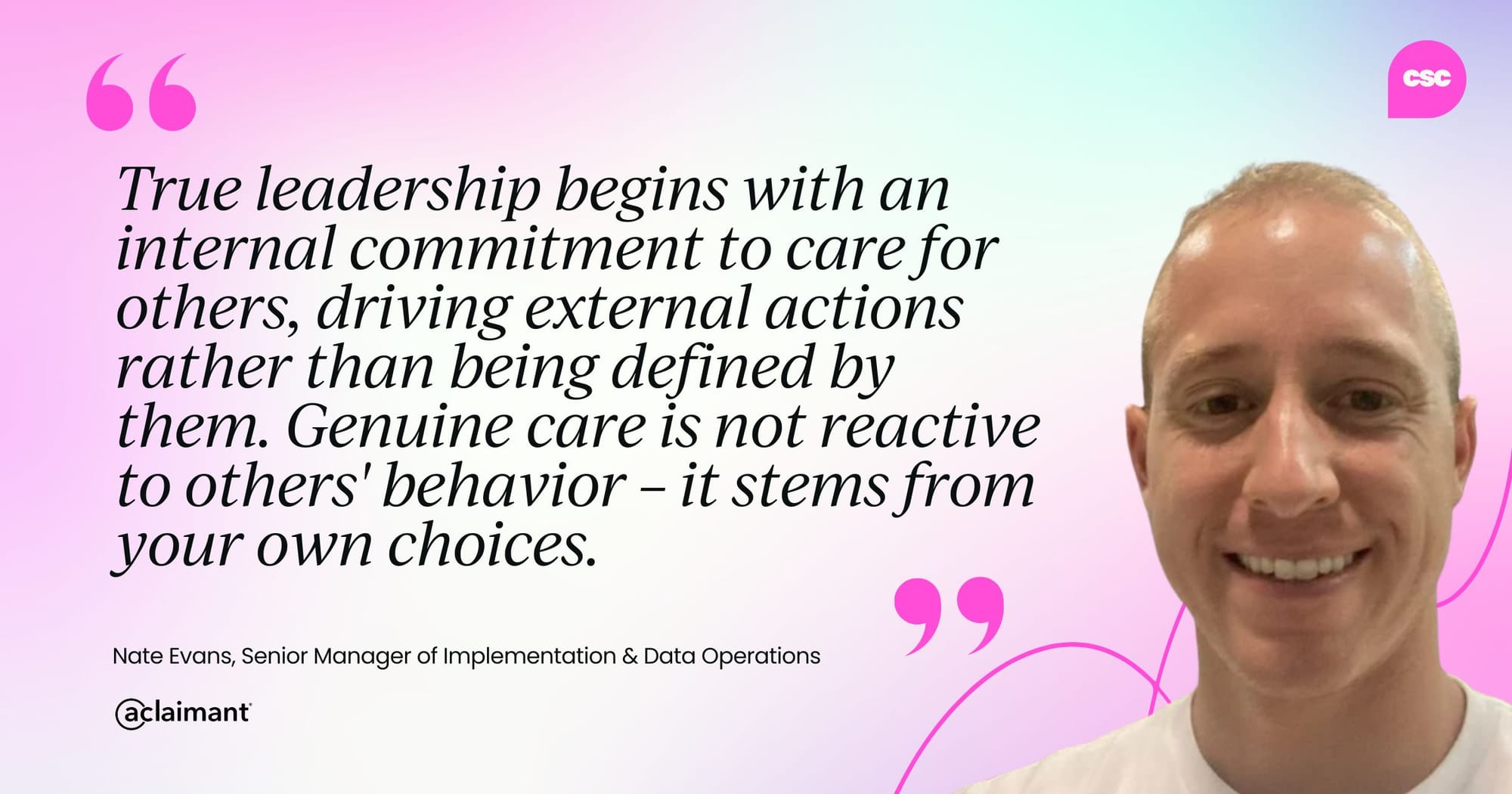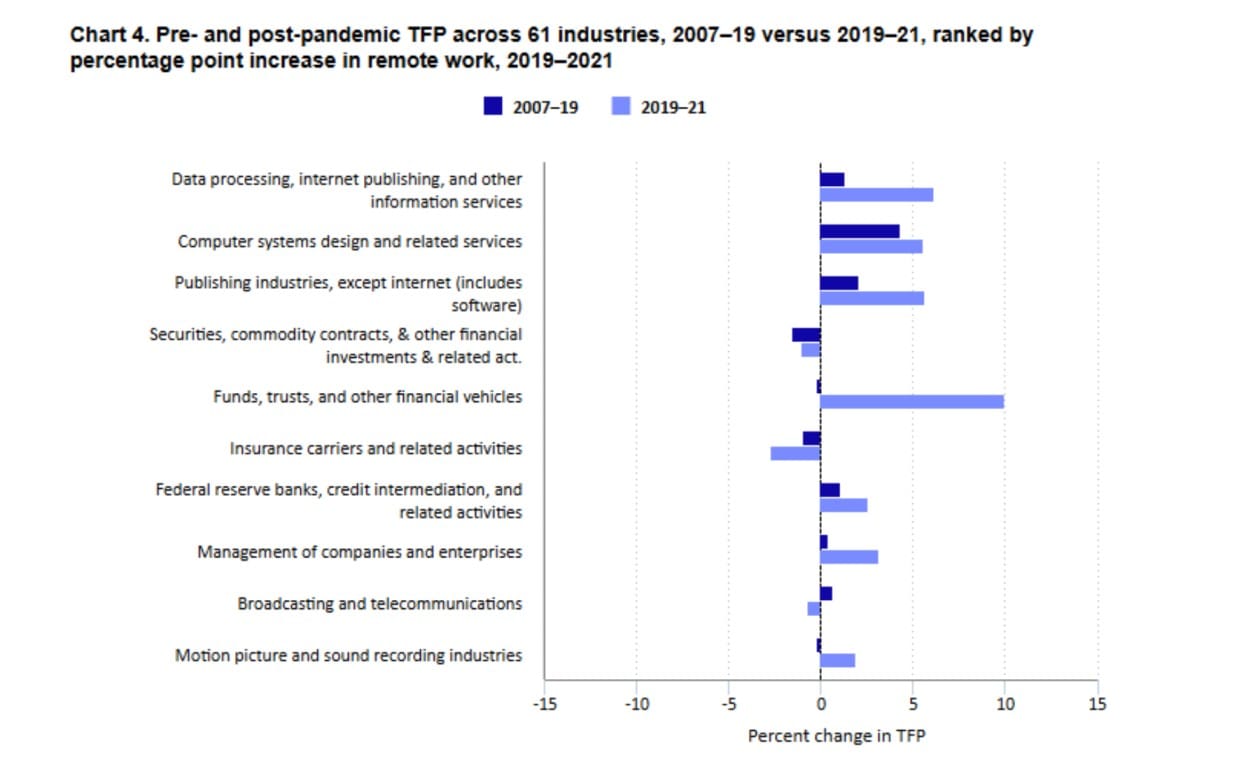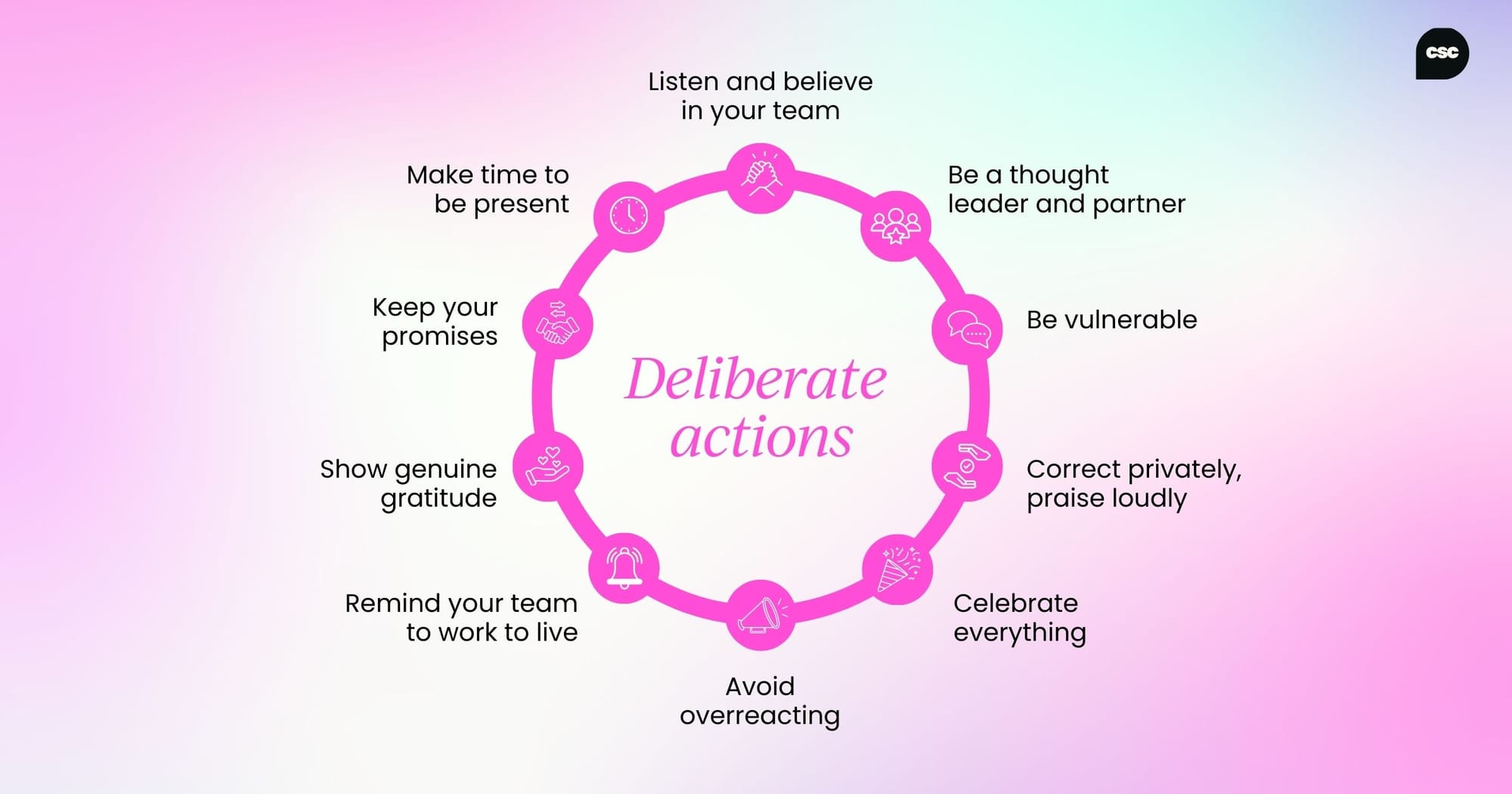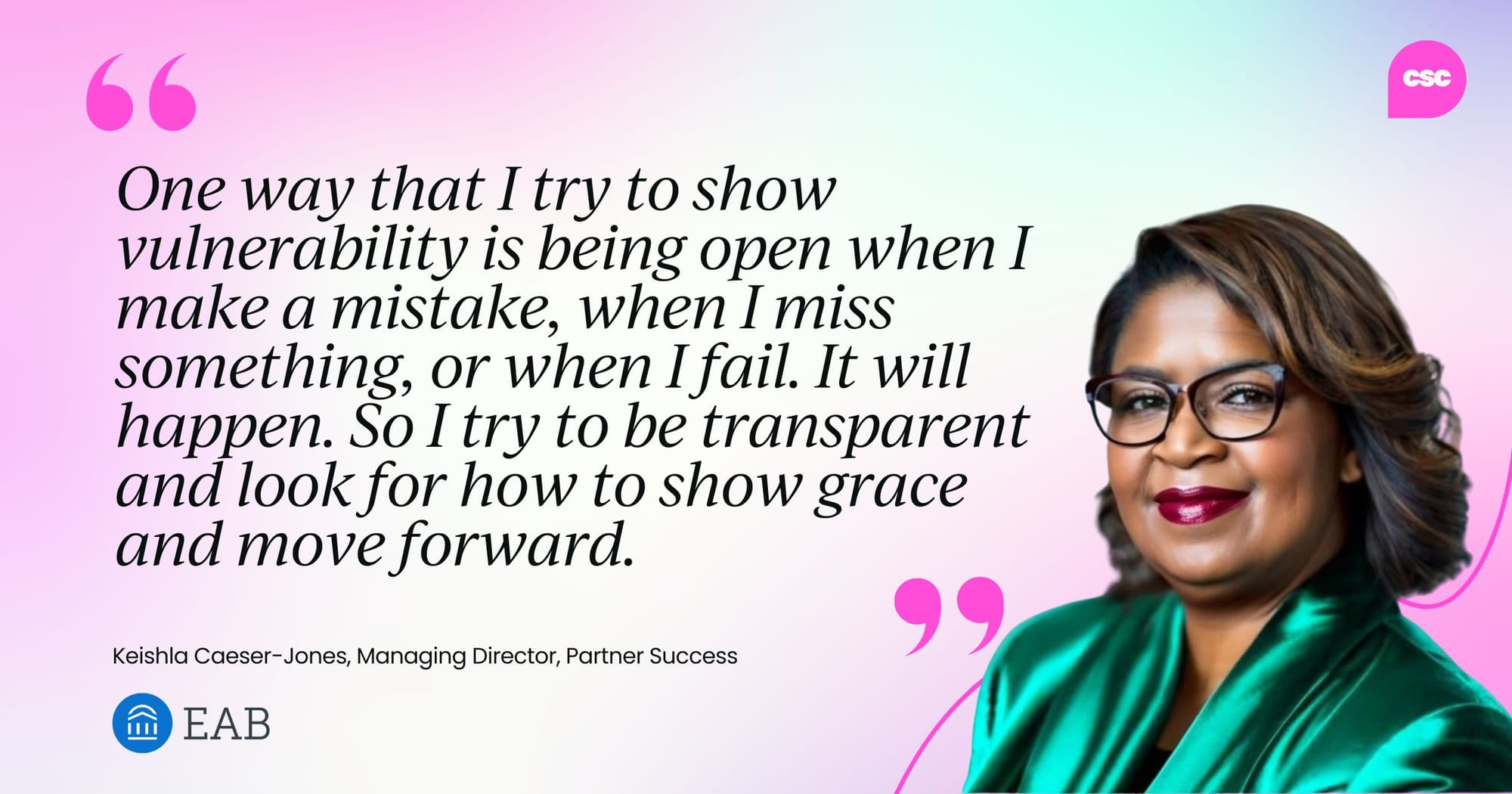This article will serve as your personal guide through the sometimes hazardous journey of leadership. Here’s what you’ll walk away with:
1. The five rules that encompass my leadership framework: These are the non-negotiable principles that have shaped my leadership approach.
2. The five promises you won’t compromise on: Leadership isn’t just about what you do; it’s also about what you refuse to sacrifice.
3. The 10 deliberate actions you can take: Because good intentions are great, but execution is everything.
Many folks are catapulted into leadership because they’re rockstars in their role – the top performers, 125% givers, and all-round role models. They might even be the team’s go-to trainer, doling out wisdom like Costco samples. But excelling at a role doesn’t prep you for leadership because spoiler alert: managing people isn't just a higher-level version of doing the job you crushed before.
Ryan Johansen, Enterprise Customer Success Manager at Bottomline, attests to this, revealing that in his transition in becoming a first-time manager, he "ended up in the hospital because of a mental breakdown caused by workplace stress.”
This strain placed on first-time managers has been backed up by Forbes, reporting that upwards to 60% of new managers fail within the first two years and direct reports are 20% more likely to leave the organization as their performance and that of their counterparts struggle through unmanaged leadership expectations.
My journey into leadership
When I stepped into my first leadership role, I had a leg up because my predecessor was proactive with succession planning.
For two whole years before my promotion, he brought me into essential conversations, like a sneak peek behind the curtain of leadership. With his busy travel schedule, I frequently had the run of standard operations. I was there for customer chats and escalations, crafting decks for QBRs, and even executing my own strategic ideas.
Once I officially got the promotion, my new leader showed confidence in me right out of the gate. From day one, I was the go-to person for my accounts and the team I now led. Most importantly, he let me make mistakes – gasp!
Yes, real, bonafide, facepalm-worthy mistakes. There were some epic ones, but he didn’t leave me floundering. Instead, he guided me, coached me, and made sure I learned. I was lucky – no, as a Black woman, I was very lucky – to have two leaders who believed in me from the jump and weren’t afraid to show it.

The good, the bad, and the ugly of leadership
Now, don’t get me wrong; not every boss in my career has been all sunshine and trust falls.
I’ve had my share of bosses who seemed to have a vendetta against my peace of mind.
Ever had a leader ban you from using certain words because they made you sound “uppity”? Or delete your carefully crafted deck because they didn’t like your creative spin (or your use of 70% black and not 80% in the text)? Or let an entire call simmer in awkward silence while you sweat through 712 pivot tables to pull a metric you didn’t know anyone wanted? Yep, same.
Bad bosses have a penchant for teaching us exactly who we don’t want to be. That Golden Rule from preschool hits different when you’re wondering if your boss sees you as a person or just a replaceable cog in the machine and a rung on their ladder to the top.
The longer I stayed in leadership, the clearer it became that I needed my own map for how to lead. Sure, I had incredible examples of what to do (and not to do), but none of them fully matched who I was or how I wanted to show up for my teams. I needed to give myself some personal leadership guidelines that would allow me to stay me, thrive, and guide others.
Building my leadership framework

Rule #1: Don’t be a jerk
Long before I heard the term EQ (emotional intelligence), I made a groundbreaking decision: I would simply not be a jerk. Revolutionary, right? Seemed like a simple place to start. This rule came easily to me because I’d been on the receiving end of leaders who seemed to have “Make Virginia 30% More Miserable” as their personal OKR.
EQ is the ability to recognize and manage our own emotions while recognizing and influencing the emotions of those around us. Employees with high EQ leaders report a 76% increase in creativity and a 61% increase in creativity.
More and more companies are recognizing the benefit to the bottom line and increasingly require their leaders and executives to have emotional intelligence as a top skill. Being brilliant and having innovative ideas is not enough if you can not communicate those ideas with respect, or you don’t know when people are frustrated or burned out.
This rule was particularly natural for me because I was an internal promotion. I wasn’t just leading a team; I was leading my team, my people.
I felt deeply honored to step into that role and was equally touched by the support I received when I was promoted. It seemed like a no-brainer to keep treating my team with the same respect and care that had brought us success and camaraderie in the first place.
And just like that, leadership rule #1 was in the books: Don’t be a jerk. Simple, effective, lovely.
Rule #2: Stay intentionally authentic
Second, I couldn’t let myself get lost in the bandwidth-measuring, cubicle-farm maze of navy-blue power ties striding off to golf courses to close deals with that “circle-back” synergy. I get why those things exist, and why they work, but that’s just not me.
I’ve been described as “a vibe, ” and I’ve chosen to take that as the high praise it clearly is. For me, that means leadership has to come with all the sparkle and authenticity that make me me.
Leading is infinitely easier when I don’t have to overthink which version of myself is “allowed” at the table. So, spoiler alert: I bring all of it! The glitter, the humor, the vibe – it’s part of the package.
While chatting with my fantastic colleague (and high-EQ leadership pro), Nate Evans, Senior Manager of Implementation and Data Operations, he took this idea a step further.

Nate made the point that real leadership isn’t just about what you do – it starts with who you are, explaining:
“True leadership begins with an internal commitment to care for others, driving external actions rather than being defined by them. Genuine care is not reactive to others' behavior – it stems from your own choices.”
And when I lead with authenticity, my team feels safe to do the same. That authenticity builds trust, boosts satisfaction, and unleashes creativity in new and unexpected ways. So, for good or for ill, I made a deliberate choice to lean into who I am, glitter and all.
Rule 3: Support everyone’s independent success
Equitable access to education, understanding, and success is core to who I am, so it was a no-brainer that as a leader, I’d prioritize investing in my team’s growth. The opportunities I was given were game-changers for my career. Sometimes, they came because leaders were willing to take a chance on me – or even put their own projects on pause to hand me the ball and say, “Run with it!”
Each year during evaluations, I talk to my team about their independent professional goals; independent of me, their current role, or our employer. I’ve been able to then provide coaching and ancillary “passion projects” to support that specific growth.
This can result in some really creative projects, massive boosts in confidence and improved team morale.
Prioritizing my team’s success means encouraging their growth in ways that are independent of me or my own achievements. It’s about opening doors they didn’t even know were there, or building an opportunity from whole cloth to support their growth. Whether it’s connecting them with resources or creating new challenges, my goal is to help my team stretch and trust in their abilities to soar.
Rule 4: Funnel the good, umbrella the bad
As I progressed in my leadership journey, I realized how crucial it was to make sure any benefits or praise that came my way were funneled straight to the team. I was in different rooms, hearing the applause and seeing the ripples of the team’s hard work across the company.
My job wasn’t to bask in that glow but to shine the spotlight back on my team so they knew just how impactful their efforts were. This became a cornerstone of how I led. Letting the team know we were on the right track wasn’t just nice – it was necessary.
The flip side? I had to shield my team from the unreasonable requests and unrealistic expectations that can sometimes roll downhill like an avalanche of nonsense. I’ve been fortunate as a leader – I’ve always had teams that were nothing short of awesome, amazing, brilliant, and hardworking. But they’re also humans. Mere mortals.
Some tasks aren’t ours to do. Some requests are just outlandish. And sometimes saying yes to one thing means dropping five other priorities. As a leader, I took it on myself to deflect as much of that chaos as I could so my team could focus on what they do best: being absolutely brilliant.
Rule 5: Be comfortable learning from anyone and everyone
When I stepped into my first leadership role, I knew one thing for sure: I was not the smartest or most experienced person on the team. Initially, I was pretty worried about this fact. I thought leadership promotions went to the most seasoned, loudest, longest-tenured folks in the room – and wee baby leader Virginia was none of those things.
Thankfully, I had an amazing boss who helped me reframe my worries. He pointed out that I had other skills that made me a natural fit for leadership, one of which was my willingness to learn from anyone, anywhere, about anything. I wasn’t afraid to say, “I don’t know,” and more importantly, I stayed confident in the things I did know. (Cue rule #2 and my commitment to authenticity!)
Frankly, I’m not always the smartest person on my team – and that’s exactly how I like it. If you’ve ever worked with me, you’ve probably heard me say, “Ooo, I don’t know!” with genuine enthusiasm and maybe even a glimmer in my eye. Why? Because “I don’t know” is a power phrase. It keeps me open to new knowledge, makes me better, and creates space for my team to shine.
In embracing what I don’t know, I empower my team to show what they do know, and level myself up at the same time.

Promises without compromises
Five. Five rules. That’s a solid start, right? At least, that’s what I thought. And while I’ve since added plenty of sub-rules, these were my original guiding principles for the kind of leader I wanted to be. But, honestly – there was no guarantee that this ridiculous list of mine was going to work.
There was nothing in this plan about business objectives, key performance indicators (KPIs), performance improvement plans (PIPs), operational efficiency, quotas, or synergy. My leadership framework was all about what I could control – me and my priorities. But the question was, how did that translate into everyday leadership? How could I bridge theory to practice? I needed to set up some standards – or “commitments,” – that would back up my rules.
Commitment #1: I will trust my people
Trust your people; it’s a game-changer. I’m happy to see that more leaders are adopting this mindset as the default, but it’s worth emphasizing because it’s the cornerstone of any successful leadership plan or relationship. Trust is foundational to building a team that thrives and feels supported.
The shift to remote work has significantly altered traditional leadership models, challenging the notion that physical presence equates to productivity. No more Bill Lumberghs able to spot check “productivity” with a mosey to the kitchen for more coffee.
And this is not a post-COVID phenomenon – we’ve known that remote work can enhance productivity and employee satisfaction for a minute now. A 2015 SHRM study and subsequent article note that 77% of employees who work remotely at least a few times per month report increased productivity, with 30% accomplishing more work in less time.
According to the Bureau of Labor and Statistics, remote work has been associated with positive impacts on industry-level total factor productivity (TFP). From 2019 to 2021, industries experienced an average 14.9 percentage-point increase in remote workers, correlating with a 1.2 percentage-point rise in TFP.

You hired good people. They are smart, capable, and invested in their work. They are deserving of respect, trust, and the autonomy to succeed in their own way. And trust isn’t just about giving them the freedom to work; it’s also about having faith that they’ll come to you when they need guidance or support. Trust is a two-way street.
When you trust your team, they trust you in return, creating an environment where everyone feels empowered to contribute, collaborate, and solve problems together.
Commitment #2: I will assume good intentions
Part of trusting my team and my coworkers is assuming good intentions. I like to use a modified version of Hanlon’s Razor. Hanlon’s Razor says, “Never attribute to malice that which is adequately explained by stupidity.” I’d amend this to: “Never attribute to malice what is the result of ignorance or misinformation.” It’s a bit of a twist but it works for me.
Hey, everyone on your team is pulling for collective success. You’d be amazed at how many folks care more about the team winning than their own personal victory. But everyone’s only working with the information they have. Not everyone knows what goes into your decision-making process, and that’s where the miscommunication gremlins sneak in.
So when miscommunications pop up with or among my team, my go-to move is to assume we’re all trying to row in the same direction – sometimes someone’s compass is just a bit off. Problems are problems, and people are people. In most cases, people aren’t the problem. It's about addressing the problem with the help of your people.
Commitment #3: I will own team deficits
If there's ignorance or missing information on the team, well… that’s on me as the leader. Remember the funnel and umbrella rule? Yes, it applies to information too!
Here’s the deal: I’m a big fan of radical transparency. If I’ve been gifted with a brilliant team (check) and I fully acknowledge that I’m not the smartest in the room (double check), then it’s on me to share what I know so we can strategize and make the best moves together.
When I notice work performance issues, my first task isn’t to point fingers – it’s to reflect. Did I set my team up for success? Did they have the knowledge, resources, strategic understanding, and – oh yeah – time? If the answer to any of these is “no,” then we’re not looking at a performance problem. We’re looking at a leadership problem – a me problem.
And if it’s my problem, I owe it to my team to own it and fix it. My job as a leader is to make sure I’m never the bottleneck or the barrier to our success. After all, if I’m supposed to be steering the ship, I can’t exactly blame the crew when I’m the one who lost the map!

Commitment #4: I will be grateful for feedback on my leadership
Owning deficits that might not be visible to my boss (yet) means I have to get feedback from the people on the front lines – the folks I lead.
One of the greatest gifts I was ever given was a 360 review. If you’ve never had one and you’re a new leader, I highly recommend asking for one! A 360 review means feedback is solicited from your superiors, peers, and direct reports. It’s like getting the “ultimate customer satisfaction survey” for your leadership skills.
And if I’m out here preaching to our customers about the importance of feedback from their frontline teams, I’d better take my own medicine, right? Getting my team’s opinion on how they feel they’re being led is gold.
Two things stuck out to me in my 360 feedback from my team. One, they had absolutely no issue separating the Virginia who cooed over baby pictures and fan-girled about K-dramas from the Virginia who would support them, get them resources, and keep them on track – who knew?!
Second, some of the things I worked so hard on that didn’t pan out ended up being the most meaningful to my team. A process that failed was seen as a valiant attempt to fix a pain point. My acknowledgment of a pain point that couldn’t be resolved made them feel seen. These were times I knew I failed as a leader, but instead, they were moments of connection and trust.
Just like in CS, you can’t improve metrics if you don’t have a baseline, and leadership is the same. The review opened the door for my team to give me feedback in our 1:1s. How could I support them better? When did they feel like I dropped the ball?
What was something I did with the best intentions that totally made a mess (oy, those support tickets I fumbled)? Every day, I have the tools and feedback to get better, because the people who see me most care enough to tell me about myself.

Commitment #5: I will not gatekeep resources
Lastly, I’m all about lifelong learning and the belief that anyone who’s willing to put in the effort should have access to the knowledge they need. No gatekeeping!
Unfortunately, many of us have encountered leaders who deliberately hoard career-building resources like a front-row ticket to an “Eras” concert. Sometimes it’s driven by fear, other times, folks just think “finders, keepers” is a life rule that extends beyond the playground.
I once coached a team member on the dangers of gatekeeping and the limited communication that comes with it. In our conversation, they mentioned a leader, “hoarding knowledge like a dragon.” Well, they’re not wrong – knowledge is valuable, but it grows in a different way than money. (See? I really do work with brilliant people!)
As for me, I believe in sharing resources, because the value of knowledge multiplies when we share it. When we make it accessible, folks with unique perspectives can contribute to making the information even more robust. Gatekeeping doesn’t keep anyone out, it just locks me in.
Did I just learn a new prompt for ChatGPT? Here you go! Did I get a fantastic new template for customer communications? I’ll get you a copy. I’ve met so many fantastic customer success pros who’ve generously shared their time, tools, and expertise with me, helping me grow. I’m committed to paying that generosity forward.
Deliberate actions you can take to be a better leader
I’m now several years into my people leadership journey – different teams, different places, different objectives. Work, studies, volunteering. This framework and these promises have served me well. But action is where leaders are made.
Talk is cheap; I needed Serena Williams-esque follow-through to make this count.

Tactic #1: I can listen to and believe my people
While I had promised I would trust my people (commitment #1) and assume good intentions (commitment #2), that involves the crucial step of critically listening to my team and, more importantly, believing them.
One of the hardest parts of customer success is when you know something to be true but still have to wait for the data to catch up. It's like having Spidey senses tingling – your brain picks up on patterns before your conscious self can name them.
These are the moments I needed to lean into my CSMs and really hear their feedback, so we could work together to validate (or invalidate) and make the best move. None of this happens if people don’t feel comfortable coming to a leader with their uncertainties.
Tactic #2: I can be a thought leader and partner
Listening and believing in your direct reports doesn’t just make you a leader; it makes you a thought partner. Brilliant people need guidance, but sometimes their ideas are so far ahead of you, you might as well be trying to catch a speeding train on a tricycle.
In these cases, you jump off the trike and into their sidecar. Your role becomes a great repository of previous experience to help shape that idea alongside them.
Let them lead. Not every idea will be a home run, but even a crummy idea can spark brilliance. There's value in the process of thinking it through together.
Like I’ve said before, I’m not aiming to be the smartest person in the room, and I’m certainly not infallible. So, having thought partners both in and out of work is essential. Partnering with team members also sets up the all-important succession planning for the team and provides a foundation for stability.
Tactic #3: I can be vulnerable
I’ve learned – thanks to my 360 reviews, and other situations – that sharing my missteps is one of the most valuable things I can do for my team.
Sharing my mistakes is the exact opposite of gatekeeping. When I share my personal snafus, there’s often an undertone of: “I already did this… badly. Now you don’t have to.” If my team is going to make mistakes, I want them to be fresh, novel, and unique – like limited edition Air Jordan white-on-white levels of new.

Keishla Caeser-Jones, Managing Director, Partner Success and EDI ERG Leader at EAB shared with me:
“One way that I try to show vulnerability is being open when I make a mistake, when I miss something, or when I fail. It will happen. So I try to be transparent and look for how to show grace and move forward.”
Keishla uses her missteps as authentic teachable moments and her team is better for it.
I’ve also used my absolute failures to show that today might be a bad day, but there are other days after today. When a direct report called me after a particularly big mistake they made, I could hear the fear in their voice – worried that this one failure would forever change my opinion of them and their work. I was able to share my own similarly epic failure from earlier in my career and demonstrate that I was still standing.
Tactic #4: I can correct privately and praise loudly
When team members do “fail”, take the time to address it, but always behind closed doors – out of earshot from their colleagues and certainly never in front of customers. I’ll say it again – never in front of customers.
We've all fallen victim to call-out culture at some point, and it's a surefire way to crush someone’s confidence. And when that happens, you’re not just hurting the individual, you’re also messing with your customer satisfaction. So, if you want to start shrinking your team through attrition, this is a great way to kick things off.
On the flip side, when someone does something great – praise loud and often! I’ve had the privilege of managing people who were sometimes their own worst critics. It became my job (and my absolute joy) to remind them of their accomplishments and ask them to step back and appreciate their own success. Last year, at the Customer Success Festival in Chicago, I was part of an insightful small-group discussion about building company culture as CS/CX leaders.
One of the key takeaways? Boosting team morale by encouraging recognition from outside of customer success and customer experience. Get others to notice and celebrate your team’s wins. It's like spreading confetti (who doesn't love confetti?)

Tactic #5: I can celebrate EVERYTHING
Speaking of confetti… Did you spot that AI-generated picture up there? Go ahead, scroll back up and take a good look.
There’s a reason AI thinks I’m sunshine and unicorns wrapped in a glittery rainbow – it’s because I celebrate all the wins. Big wins, little wins, unexpected wins, standard wins, shared wins, individual win – basically, if something even remotely resembles a win, I’m all over it. I’ll even annoy the other leaders in my organization and asking them to give their teams super loud praise and celebrate their accomplishments.
Celebrating is not just about recognizing the person or team being highlighted; it’s a signal to everyone, even the outside teams, that there’s motion, progress, and good forward momentum happening. Sometimes, it helps other teams see how their work is positively impacting others.
Take our backend teams, for example – they don’t always get to hear the praise directly from customers. That’s why it’s all the more important to share that feedback with them. Let them know that the tickets getting catapulted their way are leading to some real results.
Celebration is also a fantastic disruptor. Ever seen a team spiraling during a tough season, dealing with churn, or trying to navigate change? Finding something to celebrate – no matter how small – can reset their brains and get them back into that glorious growth mindset. It’s like a mental recharger.
Tactic #6: I can avoid overreacting
A common phrase in my house when something goes wrong is, “Welp! That’s suboptimal.” The “welp” comes from my strong Midwestern upbringing, but the “suboptimal” part is my way of taking the sting out of things. By calling it suboptimal, I can acknowledge an issue without immediately hitting the big red panic button.
There are tons of ways to handle urgent situations, but the key is for a leader to avoid dramatics and overreacting. When you overreact, you risk tipping your team into reactive thinking, which might cause them to overlook the root cause of the problem. Instead, show your team that it’s possible to think through a situation and find a resolution – not just any resolution, but a good one, without panic-induced shortcuts.
Also, keep in mind that as a leader, the team will often look to you to set the tone. This can be a tall order for those of us who aren’t always experts at schooling our faces. But by measuring your own reaction, you give your team the space to figure out how they feel about the situation or change. And that’s useful information for a people manager.

Tactic #7: I can remind them to work to live
A few years ago, some team members had their holiday PTO canceled to work on a big project. That was a tough blow for those individuals who needed that time to recover after pushing so hard to hit the finish line.
This disappointment and frustration spread throughout the team because, not only did they respect their colleagues, but they were now also worried that their vacation time could disappear – queue anxiety. And there was no love lost on that customer either for subsequent projects.
Remind your team that they work to live, never expect them to live to work. Keep track of PTO during your 1:1s (this is the one area where I might get a wee bit micromanage-y). Doctor’s appointments are not PTO. Staying home with a sick kid? Not PTO. It's borderline whether spending time with extended family during the holidays qualifies as PTO.
If people aren’t taking time off and are headed toward burnout, they won’t be able to bring their authentic, brilliant, innovative selves to work. Not encouraging your team to live full lives will come back to bite you, because at the end of the day, the team is essential to your success as a leader.
Tactic #8: I can show genuine gratitude
Speaking of being nothing without my team… I am nothing without my team, so I make sure to show them genuine gratitude. I can’t count how many times they’ve caught my errors in emails or offered up brilliant suggestions. One team member even set me up with a rapport-building detail for a key client: “Remember to ask about the dog! Her dog just had surgery!”
Gratitude comes in many forms. Of course, there’s calling out wins, as mentioned before, but it’s also about reminding people why they’re appreciated. “I appreciate you taking the time to read this a second time for me.” Or, “Thank you for pointing out how that wouldn’t have worked for those customers.” It’s not rocket surgery, it’s really just the first step in Rule #1: Don’t Be a Jerk.
As I bragged… I mean mentioned before, my direct reports have always helped me become a better leader, and sometimes that means calling me out.
This can range from reigning in my potentially toxic optimism when kicking off new projects to reminding me that I haven’t yet put my PTO on the calendar (a dose of my own medicine). I appreciate it because the day they don’t call me out and call me up is the day they’ve lost faith in me.
Tactic #9: I can keep my promises
Customer success pros all know that consistency and keeping promises are two of the most important things we do to maintain customer faith in us, our product, and the potential for their success with our help. This is equally true as a leader.
Leaders can’t always give their team everything they need – that’s a harsh reality for people-pleasers turned people-leaders and a hurdle that brings a lot of guilt to those I’ve talked to.
"Guilt is not a response to anger; it is a response to one’s own actions or lack of action."
– Audre Lorde from Sister Outsider: Essays and Speeches
The answer might not always be “yes,” but if I commit to doing something for my team, then I know I’m betting a piece of my relationship with them – double or nothin'! In this way, treat your direct reports like your customers.
Be honest when the answer is no, but if the answer is yes, make sure to share the details of the "how" and "when" along the way, and make it a priority.
Tactic #10: I can make time to be present
As a leader, it's easy to get caught up in meetings, KPIs, and all the tasks that seem urgent, but one of the most effective ways to stay connected to your team is through those informal, low-pressure check-ins. This isn’t about discussing performance or hitting targets. It’s about being present.
These check-ins are your opportunity to quietly ask, “How are you doing?” or “Is there anything on your mind that’s not on the agenda?” Sometimes, people just need to know that their leader sees them as individual humans. It's the moments where you’re not asking for something specific that open up the most honest conversations.
And this doesn't need to be a huge time commitment. Even a quick “how’s the week going?” can provide a much-needed mental reset. These small but consistent connections help build a culture of care that can positively impact morale and productivity. Remind them they are not on the road alone by making time. You're not just managing a team – you’re supporting them.

Choose your own (leadership) adventure
There you have it, and there you are. These are the building blocks of my leadership approach, and while they may shift, grow, or iterate over time – just like any good SaaS framework – they’ve been foundational in shaping the leader I am today.
Leadership is an evolving journey, one that involves constant reflection, learning, and adapting. This framework, though not exhaustive, has kept me grounded, purposeful, and connected with my team.
But leadership isn’t just about the commitments you make to others. It's also about the promises you make to yourself. And if I may offer a final piece of advice – new leader – always keep the promises you make to yourself. You are important. You are a vital part of your team, and you deserve the same respect you give to others. Too often, we get caught up in the whirlwind of supporting everyone else, that we forget to support our own well-being, growth, and boundaries.
So, whether it's finding that elusive balance between work and life, carving out time for your personal growth, or simply asking for help when you need it, remember that commitments to yourself are just as crucial as those you make to your team. After all, you can't lead others effectively if you're not taking care of you – put your own oxygen mask on first.
But this is just my framework and you will need one to fit your unique leadership style and the needs of your team. The beauty of leadership is that it’s a continual process of improvement, so don’t shy away from refining and growing with it. Heck, make some mistakes you can share with everyone later – those might make you a better leader too.



 Follow us on LinkedIn
Follow us on LinkedIn








